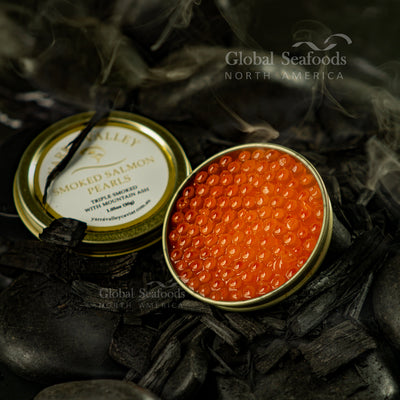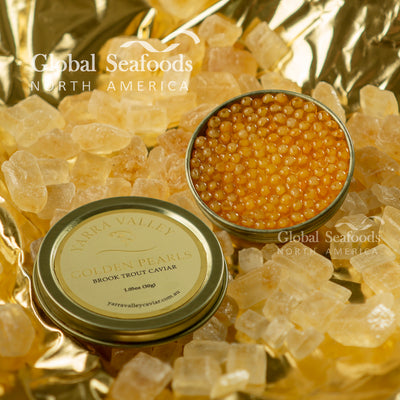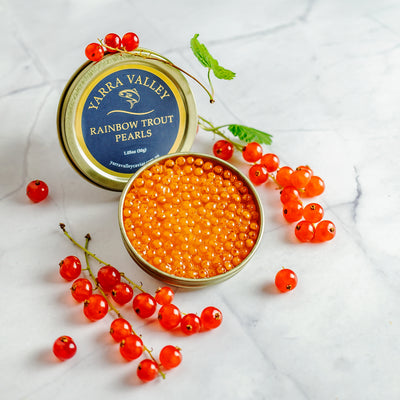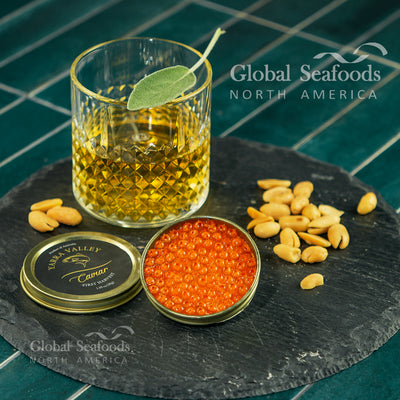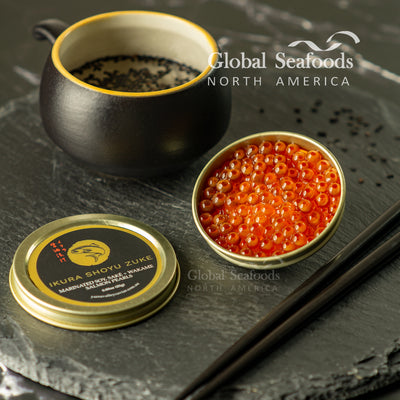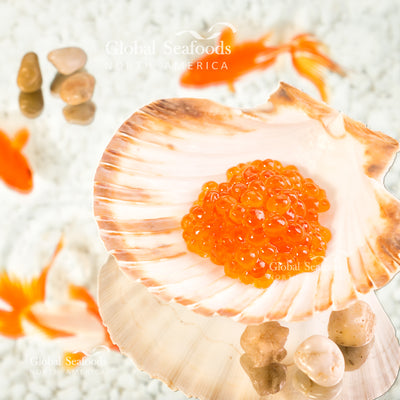Ikura Caviar vs. Other Caviar Types: Which One Is Right for You?

Ikura Caviar vs. Other Caviar Types
Caviar has long been considered a delicacy, representing luxury and indulgence. However, not all caviar is created equal. From the vibrant orange Ikura (salmon roe) to the prized black pearls of sturgeon Beluga caviar, each type offers a unique taste and experience. Choosing the right caviar for your needs can be overwhelming if you're new to the world of gourmet seafood.
In this comprehensive guide, we'll compare Ikura with other popular types of caviar, breaking down their differences in flavor, texture, nutritional benefits, and price. Whether you're looking to impress guests or elevate a special meal, knowing what sets each type of caviar apart will help you make the right choice.
What Is Ikura Caviar?
Ikura, or salmon roe, is one of the most popular types of red caviar, known for its large, translucent eggs and bright orange color. It’s commonly used in Japanese cuisine, particularly in sushi and donburi (rice bowls), but has gained popularity worldwide for its bold, briny flavor and signature "pop" when bitten into.
Unlike traditional black caviar, which comes from sturgeon, Ikura comes from various types of salmon, such as Chum, Coho, and King salmon. This makes Ikura more affordable than sturgeon caviar while still offering a luxurious, seafood-forward experience.
Key Characteristics of Ikura Caviar:
- Flavor: Briny and rich with a subtle sweetness.
- Texture: Large, firm eggs that burst with a satisfying "pop."
- Color: Bright orange to deep red, depending on the salmon species.
- Price: More affordable than traditional sturgeon caviar.
You can find premium Ikura at Global Seafoods, including options like Chum Salmon Caviar and Coho Salmon Caviar.
How Does Ikura Compare to Other Caviar Types?
To help you understand the unique qualities of Ikura and how it stacks up against other types of caviar, let's dive into a detailed comparison of taste, texture, price, and serving suggestions.
1. Beluga Caviar
Beluga caviar is considered the most prestigious and expensive type of caviar, harvested from the Beluga sturgeon in the Caspian Sea. The eggs are large and light gray, offering a smooth, buttery flavor with a delicate brininess.
- Flavor: Buttery and mild, with a subtle saltiness.
- Texture: Large, soft eggs with a smooth finish.
- Price: Extremely expensive, often the most costly type of caviar.
- Best Served: On its own, with minimal accompaniments to let the delicate flavor shine.
Ikura offers a stronger, more briny flavor compared to the mild taste of Beluga caviar, making it a great choice for those who prefer bolder seafood flavors at a more accessible price point.
2. Sevruga Caviar
Another sturgeon variety, Sevruga caviar, is known for its small, dark eggs and more intense flavor compared to Beluga. It has a more pronounced saltiness, making it a favorite among those who enjoy a stronger seafood taste.
- Flavor: Bold, briny, and slightly nutty.
- Texture: Small, firm eggs with a strong burst of flavor.
- Price: Still premium, but more affordable than Beluga.
- Best Served: On blinis with crème fraîche or alongside seafood dishes.
Compared to Ikura, Sevruga caviar has a much stronger and saltier flavor, while Ikura offers a milder, sweeter taste with larger, firmer eggs.
3. Ossetra Caviar
Ossetra caviar comes from the Ossetra sturgeon and is known for its medium-sized eggs that range in color from dark gray to gold. The flavor is nutty, with a more complex taste than other sturgeon varieties.
- Flavor: Nutty, briny, and rich, with a long finish.
- Texture: Medium-sized eggs with a firm texture.
- Price: Expensive but more affordable than Beluga.
- Best Served: On toast points or with seafood, paired with Champagne or vodka.
Ossetra offers a more nuanced flavor compared to Ikura, which has a simpler, bold brininess. However, if you're looking for a more affordable yet flavorful option, Ikura is a great alternative.
4. Trout Roe
Like Ikura, trout roe is classified as a type of red caviar. The eggs are smaller and range from orange to pale red. Trout roe is milder in flavor than Ikura, with a slightly sweeter taste.
- Flavor: Mildly briny with a hint of sweetness.
- Texture: Small, firm eggs that pop in the mouth.
- Price: More affordable than most sturgeon caviar varieties.
- Best Served: On canapés or as a topping for salads.
Ikura offers a stronger flavor and larger eggs compared to trout roe, making it a better choice for those who enjoy a more pronounced seafood taste.
5. Bloody Shiraz Infused Caviar
For a unique twist on traditional caviar, Bloody Shiraz infused caviar combines the briny flavor of roe with the rich, fruity notes of Shiraz wine. This caviar is perfect for adventurous palates looking for a new culinary experience.
- Flavor: A combination of sweet, fruity wine notes and salty brine.
- Texture: Firm eggs with a burst of flavor.
- Price: Mid-range, priced based on the infusion process.
- Best Served: As a garnish on desserts or paired with cheeses and wine.
Nutritional Benefits of Ikura vs. Other Caviar Types
Caviar is not only a luxury food but also a nutritional powerhouse. Both Ikura and traditional sturgeon caviar are rich in omega-3 fatty acids, vitamins D and B12, and high-quality protein, making them excellent additions to a healthy diet.
- Omega-3 Fatty Acids: Essential for heart health and brain function.
- Vitamin D: Supports bone health and immune function.
- Protein: Helps build and repair tissues in the body.
According to Harvard Medical School, omega-3s found in seafood, including caviar, "help lower the risk of heart disease and support mental health." While both Ikura and sturgeon caviar are nutritious, Ikura offers a more affordable option for those looking to incorporate these health benefits into their diet regularly.
How to Serve Ikura and Other Caviar Like a Chef
Now that you know the differences between Ikura and other caviar types, it's time to learn how to serve them like a pro. Here are some tips for each type:
1. Ikura on Sushi
One of the most popular ways to enjoy Ikura is as a topping for sushi or rice bowls. Serve Ikura on top of sushi rice, garnished with nori or a squeeze of lemon for a simple yet impressive dish.
- Backlink: Chum Salmon Caviar
2. Beluga Caviar on Blinis
For a more traditional presentation, serve Beluga caviar on blinis with a dollop of crème fraîche. The neutral flavor of the blinis lets the delicate caviar take center stage.
3. Ossetra Caviar with Toast Points
For a more complex and nutty caviar like Ossetra, serve it on crisp toast points with a light drizzle of olive oil and a sprinkle of sea salt to enhance its natural flavors.
4. Trout Roe on Canapés
Trout roe is perfect for canapés. Spread cream cheese or goat cheese on a cracker or cucumber slice, top with trout roe, and garnish with fresh dill.
- Backlink: Trout Red Caviar
5. Bloody Shiraz Infused Caviar with Cheese
For a creative pairing, serve Bloody Shiraz infused caviar with soft cheeses like brie or camembert. The combination of sweet and salty flavors creates an unforgettable taste experience.
- Backlink: Bloody Shiraz Infused Caviar
Where to Buy the Best Caviar Online
For the finest quality salmon roe and other caviar varieties, turn to Global Seafoods. They offer a wide range of premium caviar options, including:
- Chum Salmon Caviar: Perfect for sushi and rice bowls.
- Coho Salmon Caviar: Delicate and flavorful.
- Red Caviar: Versatile for canapés and appetizers.
- Golden Pearls Brook Trout Caviar: A unique option with mild flavor and firm texture.
Visit Global Seafoods to explore their full collection of caviar and salmon roe for your next gourmet meal.
FAQs About Ikura and Other Caviar Types
1. What’s the difference between Ikura and traditional caviar?
Ikura comes from salmon, while traditional caviar is harvested from sturgeon. Ikura is larger and more affordable, while sturgeon caviar has a more delicate flavor.
2. How should I store caviar?
Caviar should be kept refrigerated and consumed within a few days of opening. For longer storage, caviar can be frozen, but it may lose some of its texture.
3. Is caviar healthy?
Yes, caviar is rich in omega-3 fatty acids, vitamin D, and protein, making it a nutritious addition to your diet.
4. What’s the best way to serve caviar?
Serve caviar chilled, preferably on blinis or toast points, with minimal garnishes to let its natural flavor shine.
5. Where can I buy high-quality salmon roe?
You can buy premium salmon roe and caviar from Global Seafoods, a trusted source for sustainably sourced seafood.
For more seafood recipes and tips, visit our YouTube channel and explore premium seafood products at Global Seafoods.
Also in News

How to Make Sea Bream Sushi With Dry-Aged Tuna & Crab Roll — Step-by-Step With Chef Joshua
A complete guide to making Sea Bream sushi at home, including filleting, curing, slicing, and building a Dry-Aged Tuna & Crab sushi roll. Chef Joshua shares professional tips for restaurant-quality results.

Boiled Crab for Game Night: Everything You Need for a Perfect Seafood Party
Take your game night to the next level with a Boiled crab party. Learn the best recipes, cooking tips, and hosting hacks for a memorable seafood feast.

Boiled Crab for Date Night: A Romantic Guide to the Perfect Seafood Feast
Make your next date night unforgettable with a romantic Boiled crab experience. This guide covers everything you need to know, from ambiance to the best crab varieties.



